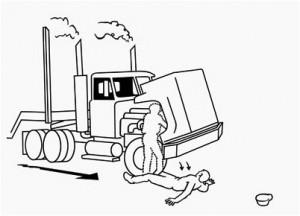BACKGROUND: A driver was waiting for his truck to be loaded at the log deck on a summer morning in the Southeast. The driver had previously made adjustments to his truck’s clutch, and he decided to continue working on it while waiting for equipment to clear the loading area.
PERSONAL CHARACTERISTICS: The contract truck driver was in his mid-50s and had been driving for at least ten years. He was considered fully trained and reliable. He was wearing a hard hat.
UNSAFE ACTS AND CONDITIONS: The driver left the truck engine running while he worked on the clutch from under the hood of his truck. It is not known whether he had set the parking brake.
ACCIDENT: Suddenly the truck jumped into a forward gear (possibly due to the clutch engaging) and knocked the driver to the ground. The driver landed in a position parallel to and in front of the passenger tire. As the truck continued forward, the tire tracked in between the driver’s legs, over his torso, and along his shoulder. The driver moved his head and rolled toward the center of the truck in expectation of more tires running over him. Fortunately, the truck hit a standing tree and stopped.
INJURY: Two logging employees immediately arrived at the scene and shut the engine off, as the wheels were still spinning. One employee called 911, and the ambulance arrived in about ten minutes. The truck driver was transported to a regional hospital by medivac. He had suffered broken ribs, a punctured lung, punctured bladder, cracked pelvis, and internal bleeding. He was hospitalized for 60 days. The truck cab/hood sustained about $1,800 worth of damage.
RECOMMENDATIONS FOR CORRECTION: Set the parking brake and shut off the engine before exiting the cab to work on troubleshooting or repairs inside the engine compartment.
It is dangerous to troubleshoot a truck problem in the woods. Fix problems at the shop or at a repair facility before it becomes a bigger problem on the road. Perform a complete walk-around inspection of the truck before each work shift, and finish (and document) all repairs before placing the vehicle in operation.
Trucking employers should ensure that all drivers are trained in hazard recognition, safe operation, and safe maintenance procedures.
 Courtesy of the Forest Resources Association: https://www.forestresources.org/
Courtesy of the Forest Resources Association: https://www.forestresources.org/
